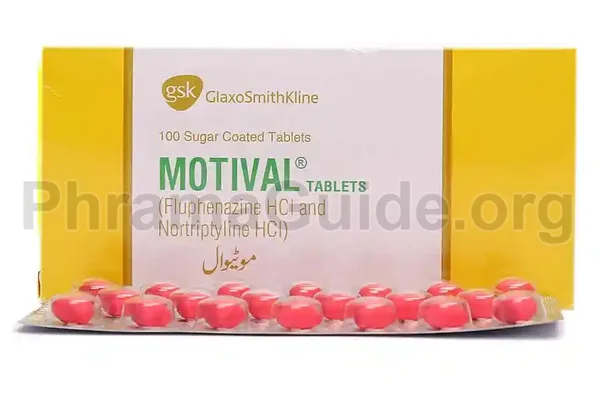Motival is used to treat various mental health conditions. It’s important to note that Motival can increase the risk of side effects and drug interactions. The specific side effects and their frequency can vary from person to person, the following are some common and less common side effects associated with Motival:
Common Side Effects
- Sedation: Motival is a sedative medication that can cause fatigue, sleepiness, and drowsiness.
- Dry Mouth: The ingredients of Motival can cause dry mouth.
- Constipation: Motival can cause constipation in some individuals.
- Blurred Vision: Motival may increase the risk the blurred vision.
Less Common Side Effects
- Extrapyramidal Symptoms (EPS): Motival is a typical antipsychotic medication and can lead to EPS, which includes symptoms like tremors, muscle rigidity, restlessness, and dystonia.
- Orthostatic Hypotension: Motival can cause orthostatic hypotension. This is a drop in blood pressure that occurs when standing up from a sitting or lying position.
- Cardiac Effects: Motival may affect heart rhythm, which can be problematic when combined with other medications. It’s important to monitor for any irregular heartbeats or palpitations.
- Serotonin Syndrome: In rare cases, Motival can lead to serotonin syndrome, a potentially life-threatening condition characterized by symptoms like confusion, agitation, rapid heart rate, and high fever.
- Neuroleptic Malignant Syndrome (NMS): Motival, being an antipsychotic medication, carries a risk of NMS, which is a rare but serious condition characterized by muscle rigidity, fever, and changes in mental status.

What is Motival?
Motival is one of the leading brands of Fluphenazine HCl + Nortriptyline HCl, manufactured and marketed by GlaxoSmithKline Pakistan.
Motival : Available Formulations and Strengths
Presently, Motival is available in Tablet Form with the following strengths
Motival Tablet : Fluphenazine HCl 0.5mg + Nortriptyline HCl 10mg
What Are The Possible Drug Interactions of Motival?
- Additive Sedation: Although Motival is a combination of Fluphenazine and Nortriptyline can cause sedation as a side effect. When used Motival, the sedative effects may be additive, leading to increased drowsiness and impaired cognitive function. Motival can be especially risky when driving or operating heavy machinery.
- Orthostatic Hypotension: Motival can lower blood pressure, leading to orthostatic hypotension (a sudden drop in blood pressure when changing positions). The risk of orthostatic hypotension is increased, which can result in dizziness, fainting, or falls.
- Anticholinergic Effects: In Motival, Nortriptyline has strong anticholinergic properties, which can lead to dry mouth, constipation, urinary retention, and blurred vision. Fluphenazine can also cause these effects, and combining the two medications may intensify these side effects.
- Extrapyramidal Symptoms (EPS): Motival has Fluphenazine, as an antipsychotic, which may lead to extrapyramidal symptoms (EPS) such as dystonia, parkinsonism, and akathisia. Nortriptyline can exacerbate EPS due to its anticholinergic effects. Careful monitoring is necessary.
- Serotonin Syndrome: Although in Motival, Fluphenazine primarily affects dopamine receptors, it can interact with Nortriptyline, which affects serotonin levels. This interaction can potentially lead to serotonin syndrome, a rare but serious condition characterized by agitation, confusion, rapid heart rate, and high fever.
- Neuroleptic Malignant Syndrome (NMS): In Motival, Fluphenazine carries a risk of neuroleptic malignant syndrome (NMS), a rare but severe condition characterized by muscle rigidity, fever, and altered mental status. Combining it with Nortriptyline may increase the risk of NMS.
- Cardiac Effects: Motival can impact heart rhythm, potentially leading to arrhythmias, particularly in high doses or in individuals with a history of heart conditions.
- Interference with Serum Electrolytes: Motival can interfere with serum electrolyte levels, such as potassium and sodium. This can potentially lead to dangerous imbalances in electrolytes, especially in high doses or with prolonged use.

Leave A Comment